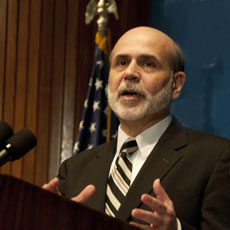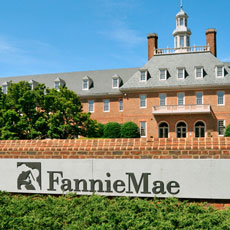Post-Crisis Use of Financial Market Data in Bank Supervision - Timeline
April 2007
- New Century Financial Corporation files for Chapter 11 bankruptcy (April 2).
June 2007
- Bear Stearns suspends redemptions from its High Grade
- Structured Credit Strategies Enhanced Leverage Fund (June 7).
July 2007
- Bear Stearns liquidates two hedge funds that invested in various types of mortgage-backed securities (July 31).
August 2007
- The FOMC votes to maintain its target for the federal funds rate at 5.25 percent (Aug. 7).
- BNP Paribas halts redemptions on three investment funds (Aug. 9).
- The Federal Reserve Board announces that “in current circumstances, depository institutions may experience unusual funding needs because of dislocations in money and credit markets” (Aug. 10).
September 2007
 The FOMC votes to reduce its target for the federal funds rate 50 basis points to 4.75 percent (Sept. 18).
The FOMC votes to reduce its target for the federal funds rate 50 basis points to 4.75 percent (Sept. 18).
November 2007
- Financial market pressures intensify, reflected in diminished liquidity in interbank funding markets.
December 2007
- The Federal Reserve Board announces the creation of a Term Auction Facility (TAF) (Dec. 2).
January 2008
- Bank of America announces purchase of Countrywide Financial (Jan.11).
March 2008
- The Federal Reserve Bank of New York announces financing to facilitate JPMorgan Chase’s acquisition of Bear Stearns (March 24).
July - August 2008
 The Office of Thrift Supervision closes IndyMac Bank (July 11).
The Office of Thrift Supervision closes IndyMac Bank (July 11). - The Treasury Department announces additional support for Fannie Mae and Freddie Mac (July 13).
- The FOMC releases a statement about the current financial market turmoil (Aug. 17).
September 2008
- The Federal Housing Finance Agency (FHFA) places Fannie Mae and Freddie Mac in government conservatorship (Sept. 7).
- Bank of America announces its intent to purchase Merrill Lynch for $50 billion and Lehman Brothers files for bankruptcy (Sept. 15).
- The Federal Reserve Bank of New York lends up to $85 billion to the American International Group (AIG) and the Reserve Primary Fund “breaks the buck” (Sept. 16).
- Goldman Sachs and Morgan Stanley approved to be bank holding companies by the Federal Reserve (Sept. 21).
- JPMorgan Chase acquires the banking operations of Washington Mutual with assistance from the FDIC (Sept. 25).
October - November 2008
- The Treasury Department announces that the Troubled Asset Relief Program (TARP) will purchase capital in financial institutions (Oct. 14).
- PNC Financial Services purchases National City Corporation (Oct 24).
- The U.S. Treasury Department, Federal Reserve and FDIC jointly announce support for Citigroup (Nov. 23).
- The Federal Reserve creates the Term Asset-Backed Securities Lending Facility (TALF) (Nov. 25).
January - February 2009
- The Treasury, Federal Reserve and FDIC announce support for Bank of America (Jan. 16).
- The federal bank regulatory agencies introduce the Supervisory Capital Assessment Program (SCAP) or “stress test” (Feb. 25).
May 2009
- The results of the SCAP exercise are released to the public (May 7).
December 2009
- Greek debt is downgraded by Fitch Ratings, and S&P warns about future downgrades (Dec. 10).
February 2010
- Several special lending facilities started by the Federal Reserve during the crisis expire (Feb. 1).
April - May 2010
- 10-year Greek bond yields rise above 9% in the secondary market by the end of April. The European Union (EU) and the IMF agree to a EUR 100 billion bailout package for Greece on May 2.
- The EU decides on a comprehensive package of measures to preserve financial stability in Europe, including a European Financial Stabilization mechanism with a total volume of up to EUR 500 billion (May 10).
November 2010
- 10-year Irish bond yields rise above 9% in the secondary market by the end of November. The EU and the IMF agree to a EUR 85 billion bailout package for Ireland on May 29.
April - May 2011
- Portugal formally requests a bailout on April 6. 10-year Portuguese bond yields continue to rise to 10% during May. The EU and IMF agree to a EUR 78 billion bailout for Portugal on May 16.
July 2011
- The EU and the IMF agree to release funds promised to Greece under the May 2010 bailout package and agree to prepare a second aid package.
August 2011
 10-year bond yields for Italy and Spain both rise above 6% in early August. The European Central Bank says it will buy government bonds from these countries to try to bring down their borrowing costs.
10-year bond yields for Italy and Spain both rise above 6% in early August. The European Central Bank says it will buy government bonds from these countries to try to bring down their borrowing costs.
October 2011
- Belgium, France and Luxembourg agree to bail out the troubled bank Dexia. European banks are told to raise more capital.
- European leaders obtain an agreement from banks to take a 50% loss on the face value of their Greek bonds as part of a plan to restructure Greece’s debt.
July 2012
- The president of the European Central Bank says the institution will do “whatever it takes” to preserve the euro.
Source: Federal Reserve Bank of St. Louis, The Financial Crisis Timeline







